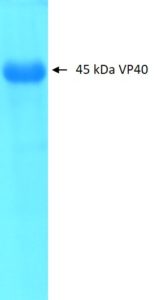SDS-PAGE: Coomassie-stained SDS-PAGE showing purified Ebola virus VP40.
Ebola Virus VP40 (Zaire)
Price range: $651.64 through $2,284.93 excl. VAT
This product is a recombinant Ebola virus (Zaire) VP40, expressed and purified from E. coli with greater than 95% purity for development of ELISA and rapid test immunoassays.
EBOLA VIRUS VP40 (ZAIRE)
Ebola Virus VP40 (Zaire) is a recombinant protein expressed and purified from E. coli.
PRODUCT DETAILS – EBOLA VIRUS VP40 (ZAIRE)
- Ebola Virus VP40 (Zaire) full length (325 aa) expressed and purified from E. coli with a C-terminal 6xHis tag.
- Presented in Phosphate buffer with 25mM arginine, 0.02% sodium azide.
- Appropriate for use in the development of immunoassays with high specificity and sensitivity.
BACKGROUND
Ebola virus is one of the deadliest viruses known to man, causing infrequent outbreaks of hemorrhagic disease with case fatality rates up to 90%. (Lehrer et al., 2019).
Ebola virus particles comprise seven structural proteins of which four (nucleoprotein (NP), VP35, VP30, and the RNA-dependent RNA polymerase (L)) are components of the ribonucleoprotein complex that is responsible for viral genome replication. Glycoprotein (GP), VP40, and VP24 are membrane-associated proteins and VP24 is believed to be involved in nucleocapsid formation. VP40 (viral protein 40 kDa) is the most abundantly expressed viral protein during filoviral infection. It is a major structural protein that plays a central role in virus assembly and budding at the plasma membrane of infected cells. VP40 proteins associate with cellular membranes, interacting with the cytoplasmic tails of glycoproteins and binding to the ribonucleoprotein complex.
The VP40 monomer consists of two protein domains connected by a flexible linker; the N-terminal oligomerization domain and the C-terminal membrane-binding domain. VP40 goes through intermediate states of assembly (e.g. octamers) (Silva et al., 2012) but both domains fold into beta sandwich structures of similar topology (Dessen et al., 2000). Within the N-terminal domain there are two overlapping L-domains (PTAP and PPEY, residues 7 to 13), which are required for efficient budding (Timmins et al., 2003) by interacting with specific host cellular proteins, such as tsg101 and vps-4 (Licata et al., 2003).
Vaccine candidates have been described containing the EBOV glycoprotein with matrix proteins VP24 and VP40 (Lehrer et al., 2019). Indeed, recombinant expression of VP40 in mammalian cells generates virus-like particles that are morphologically similar to live virus, but non-infectious. (Silva et al., 2012). These VLPs have been shown to protect mice from a challenge with a lethal dose of mouse-adapted Ebola Virus (Zaire). Antiviral therapeutics directed against the VP40 domains are also in development (Madara et al., 2015).
REFERENCES
- Dessen et al. (2000). Crystal structure of the matrix protein VP40 from Ebola virus. The EMBO Journal. 19 (16): 4228–4236.
- Lehrer et al. (2019). Recombinant subunit vaccines protect guinea pigs from lethal Ebola virus challenge. Vaccine. 2019 Jul 16.
- Licata et al. (2003). Overlapping motifs (PTAP and PPEY) within the Ebola virus VP40 protein function independently as late budding domains: involvement of host proteins TSG101 and VPS-4. J. Virol. 77 (3): 1812–9.
- Madara et al. (2015). The multifunctional Ebola virus VP40 matrix protein is a promising therapeutic target. Future Virol. 10(5): 537–546.
- Silva et al. (2012). Assembly of Ebola Virus Matrix Protein VP40 Is Regulated by Latch-Like Properties of N and C Terminal Tails. PLoS ONE. 7 (7): e39978.
- Timmins et al. (2003). Ebola virus matrix protein VP40 interaction with human cellular factors Tsg101 and Nedd4. J. Mol. Biol. 326 (2): 493–502.


